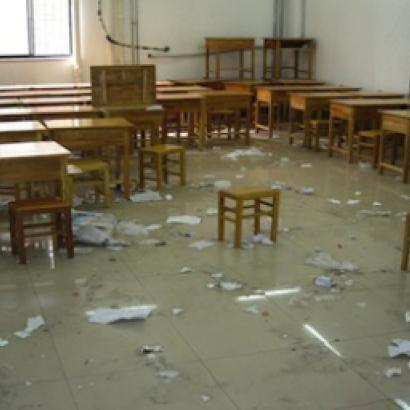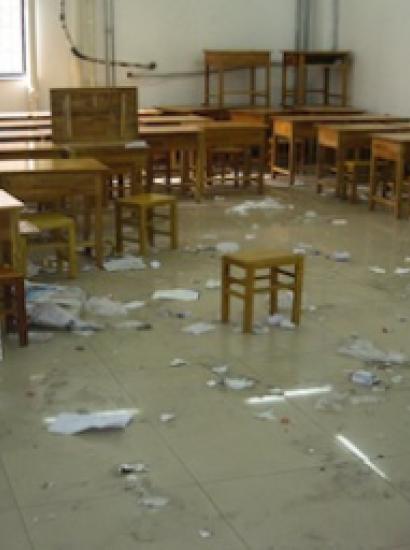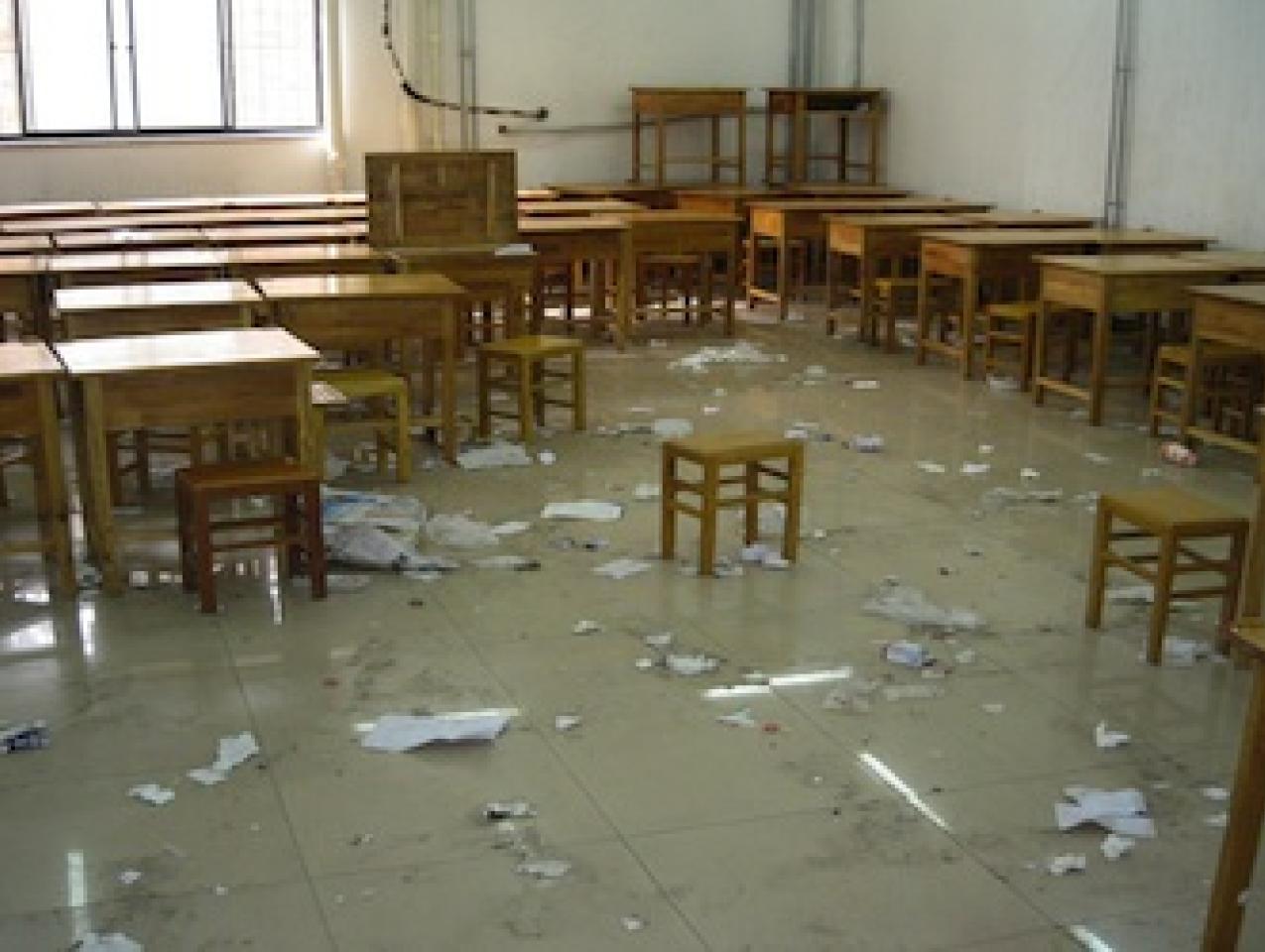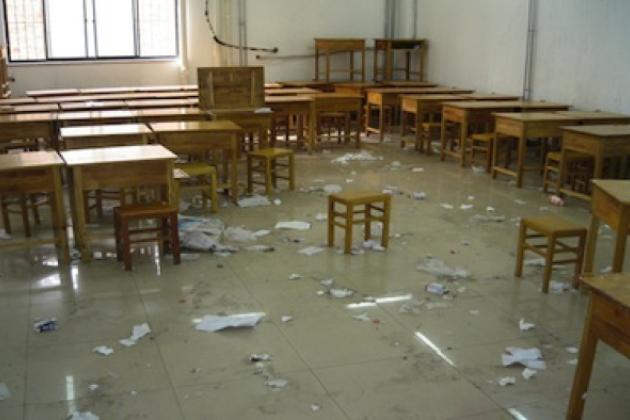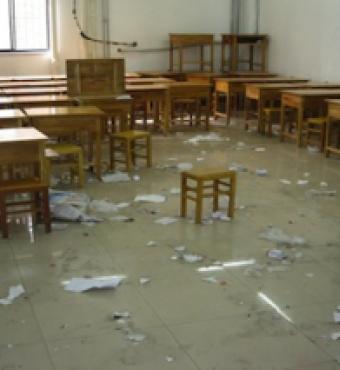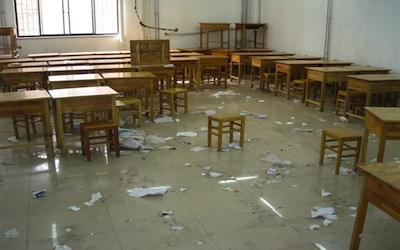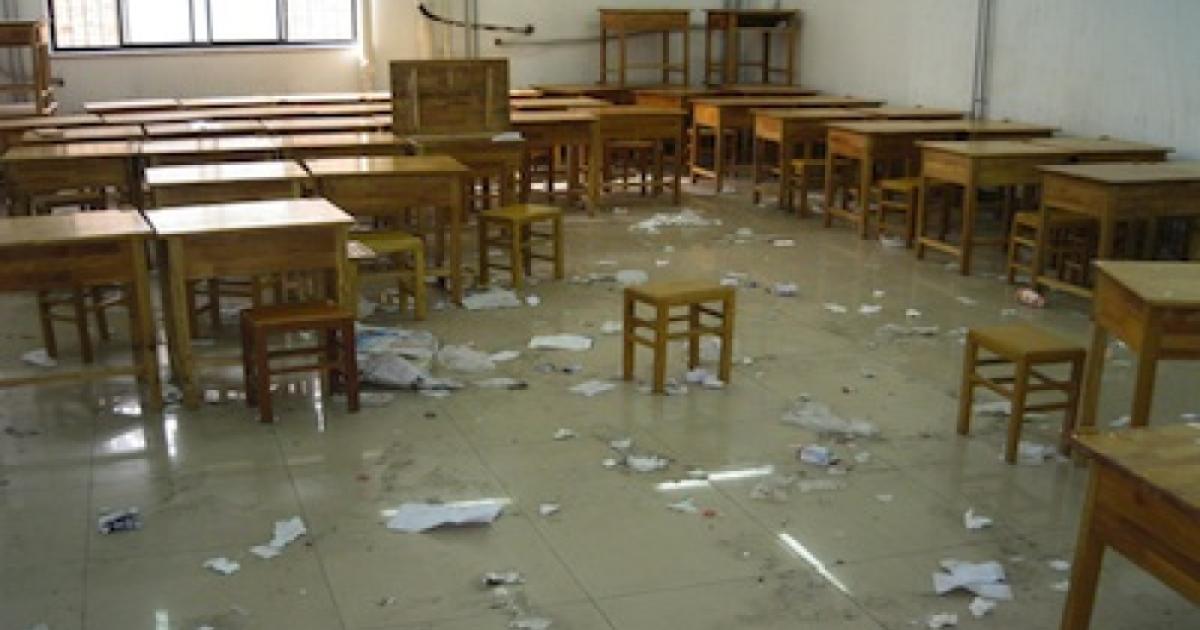- Education
- K-12
Sitting in his book-lined office at the Hoover Institution, overlooking Stanford University’s handsome campus, education guru Terry Moe bluntly tells me, "Most political science has no impact on anything."
Moe, by the way, has been a member of Stanford’s political science faculty for over twenty years, and is a political scientist by training.
But his unpredictable academic path—lined with history’s serendipitous accidents, mountains of empirical data, and, of course, painstaking work—is not one completely devoted to political science. Rather, Moe has achieved scholarly stardom with the work he has done on K-12 education: he is one of the leading experts on education reform in the country.
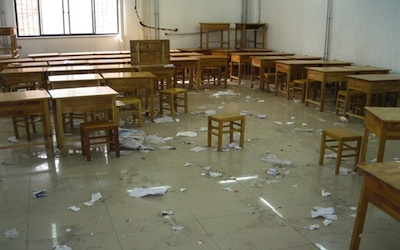
Image credit: vfowler/flickr
Recalling the early tension between his education work and his political science work, he says, "When I’m on my death bed looking back on my life, I suspect I’ll regard the most important things I’ve done with my career as those having to do with education—because they have actually had some sort of impact on the world."
One of the bullet points on that list will be Moe’s new book. He shows me, with noticeable excitement, a bound galley of Special Interest: Teachers Unions and America’s Public Schools.
"Most political science has no impact on anything."
"I’ve been working on this for years." It is his masterpiece, an A-Z on teachers unions that has just been published. Explaining the thrust of his book, Moe emphatically tells me that "The teachers unions are the main reason why the quarter-century-long movement to reform this nation’s schools has been such a disappointment."
But in the decades ahead, Moe says with conviction, that obstacle will eventually be removed. In the concluding chapter of his book, he explains that there are important political forces at work these days—Race to the Top, for example, and a burst of reformist sentiment within the Democratic Party—that are putting the teachers unions on the defensive. He argues that the decisive blow to union power will not come from inside the education or political systems, but rather from an outside force whose magnitude is so great and so overwhelming that the unions cannot fend it off.
That force is the revolution in information technology: a revolution that is fast transforming human society throughout the world—and is about to invade and transform American public education. One major impact: the eventual dissolution of teachers unions, the largest and most powerful impediment to school reform. The other impact? Well, do not be alarmed if your child comes home from school and gleefully announces that he spent his day playing "games" on a school computer.***
If you ask Terry Moe where he’s from, his line is that "I didn’t grow up anywhere. My dad was in the Air Force, so we moved a lot." Moe spent his youth in states as varied as Tennessee, Indiana, California, and Alabama. But one theme that persisted through his childhood, and which of course stayed with him in his later years, was politics: "I’ve been interested in politics my whole life. My dad was very interested in politics too. When I was just a little guy, I was following President Eisenhower, national politics, the Cold War, and the Soviet Union—and trying to talk to my dad about these things."
Moe was also a little guy when school choice arguably received its official debut on the American scene in 1955. In that year, Milton Friedman made an early proposal for a voucher system in "The Role of Government in Education" (followed in 1962 by his more widely read Capitalism and Freedom). "From that point on, during the sixties and seventies," Moe says, "there was some discussion of vouchers, but not a whole lot."
Meanwhile, as Moe was finishing up high school in the early sixties, his father was sent to Vietnam, and his family moved to Southern California—San Diego specifically. He eventually attended the public university in town, intent on studying political science. But he explains, "UCSD didn’t have a political science department in the late 1960s. It was a new campus at that time. So I majored in economics instead—and as it turned out, I got a great background in rational choice theory and quantitative analysis, which provide a great foundation for studying political science."
In 1971, after he graduated from UCSD, Moe enrolled in a doctoral program in political science at the University of Minnesota. "It was a struggle in the beginning. Even though I knew a lot about the substance of politics, I knew nothing about political science as an academic field." But he found his way at Minnesota and eventually met a fellow student there who has since become his friend and longtime colleague, John Chubb.
Moe believes that the unions’ days are numbered.
Moe earned his PhD in 1976, with a dissertation that explored the membership and organizational foundations of political interest groups. The Organization of Interests was later published in 1980 by the University of Chicago Press.
As Moe was entering into the world of academia, there was one specific interest group that was organizing itself and gaining some serious traction: the teachers unions. Walking me through the history of the reform movement, he tells me, "Unions were not a force in public education prior to 1960. But starting in the sixties, the states started to change their laws—authorizing and promoting collective bargaining—and this is when unions began to get established and become powerful."
Moe explains that it started in New York City, but quickly spread to other states: "The American Federation of Teachers wanted to organize teachers all across the country—and the National Education Association, which until then had just been a professional association, needed to decide whether to transform itself into a union and compete with the AFT for membership. That, of course, is what it chose to do."
"The two organizations competed for 15 to 20 years, and when the dust settled in 1980 or so, public education was thoroughly unionized. Collective bargaining was the norm, and unions were by far the most powerful force in public education. The result was a fundamentally different kind of education system, with the teachers unions as its chief spokesmen and defenders."
That said, in the early 1980s, Moe was not too concerned with teachers unions, nor with education—but that would all change very soon.
After working at Michigan State University for five years, Moe returned to California for a job at Stanford in 1981. His old friend, John Chubb, was in Stanford’s political science department too. Moe recalls that in those days, Chubb was researching political bureaucracies. "He had done some work on how federal grants are made to the states and his focus had been on education. He kept telling me ‘why don’t we do something together’ and I kept saying, ‘I’m not interested in education.’" Moe resisted Chubb’s siren call, focusing his scholarship on topics like the presidency, bureaucracies, and political institutions more generally. "I wasn’t an education guy," he explains.
"The school choice movement was not much of a movement until 1980, when two important things happened..."
Right at that same time, Chubb became involved with a group of education scholars from around the country, including a small group at Stanford, who were involved in designing an enormous national survey of high schools, students, teachers, and administrators. Reluctantly, Moe decided to join the project, "so that John and I would have an opportunity to work together. We weren’t quite sure what direction we were going in, but from the outset we thought we would probably explore differences between private and public schools and try to understand why those differences were occurring."
While Moe and Chubb were crunching the numbers from their survey, "in 1984, we both got jobs at Brookings," the Washington DC-based think tank. Paul Peterson, the education scholar who was then head of Government Studies at Brookings, hired the duo. Today, all three of them serve on Hoover’s Koret Task Force on K-12 education.
History was converging because it was in those years that the choice movement was picking up steam after hanging in the air for the decades since Friedman’s pronouncement on vouchers. "During the sixties and seventies, the school choice movement was not much of a movement," Moe tells me. "But that all changed in 1980 when two important things happened. One is that, when Ronald Reagan became president, attitudes towards markets, choice, and competition became much more favorable."
The second was the publication of "A Nation At Risk," a report detailing the rising tide of mediocrity in America’s schools. The tenor of the report, Moe says, "was that the performance of the nation’s education system was a serious problem and something needed to be done about it." Recall that it was in the 1980s that the teachers unions reached the zenith of a wave of power that they have been riding ever since.
Moe sees an irony in this: "Unions achieved this position of extraordinary power at about the same time that 'A Nation At Risk' came out. It was a weird confluence of historical events: just when the nation realized it needed to significantly improve its public schools, the unions were in a position to stop reform. This is why education reform has failed: because it occurred at a time when unions could prevent it."
But there was a third event that would color the future of the reform movement. Nearly a decade after starting the education project with Chubb—"it just took forever to complete our analysis, and in the meantime our ideas had evolved considerably," says Moe—the two of them published a seminal book in 1990 called Politics, Markets and America’s Schools, a book about "why the public school system was not performing well" and why reforms aimed at fixing it were unlikely to succeed.
"Just when the nation realized it needed to significantly improve its public schools, the unions were in a position to stop reform. This is why education reform has failed."
According to a summary of the book, "The fundamental causes of poor academic performance…are not to be found in the schools, but rather in the institutions of direct democratic control by which the schools have traditionally been governed"—institutions which the unions hold in their tight, iron grasp. The solution to this problem, the book argued, is an approach to reform that gives schools much more autonomy and parents much more choice.
The publication of Politics, Markets and America’s Schools, Moe observes, "basically changed my life."
To say that the book rocked the education work would be an understatement. It gave school choice advocates the kick they needed to take off as a real movement, synthesizing a body of thought that lawmakers and policymakers could actually implement. "There was a big conference for the book and a lot of news coverage. I never expected we’d receive so much attention. Everyone was reporting that the book would give the choice movement a big boost."
Moe goes on, "It’s one of those accidents of history, but the book came out at exactly the right time." In 1990, the same year Politics, Markets, and America’s Schools came out, the first American voucher program was adopted in Milwaukee. "What happened in Milwaukee," Moe tells me, "was stunning because it was a revolt of poor people, who were demanding the right to escape from the abysmal public schools in their city. Up to that point, vouchers had always been associated with Milton Friedman and conservatives. But from then on, vouchers were about bringing equity to the poor."
Then in 1991, Minnesota became the first state to adopt charter school legislation. These two achievements, although limited in scope, were monumentally symbolic. "Before 1990, school choice involved magnet schools or choosing between public schools. But now, with these new victories by the choice movement, parents were allowed to choose alternatives that were not under the control of school districts at all. Charter schools and private schools were highly autonomous compared to regular public schools. And they were almost always nonunion."
This spelled bad news for the unions, which were concerned about the impact these reforms would have on their membership numbers—and thus on their finances and their power. "At this point, the reform movement became a serious political threat to the unions and the traditional system they sought to protect." The unions responded by using their formidable power in the political process to block or weaken charter school and voucher legislation, to thwart accountability standards for teachers, and to maintain their stronghold over the educational establishment.
But Moe believes that the unions’ days are numbered. In the twenty years since Politics, Markets, and America’s Schools was published, and especially in recent years, Moe has devoted a portion of his research time to a study of the revolutionary impact technology will have on the classroom—and on the educational establishment. "The effects of technology stand to be so far-ranging and profound that the unions are literally trying to stop it. It threatens their jobs—and ultimately their power."
The publication of Politics, Markets and America’s Schools, Moe observes, "basically changed my life."
He goes on, "in the final analysis, what technology requires is a substitution of technology for human labor. Computers will do a lot of what teachers do now." Jumping forward in his chair, he lights up: "Technology is cheap. Labor is really expensive. Education has always been very labor intensive, so if our education system can substitute technology for labor and still provide kids with high quality education, then great!"
Moe explains that technology will fundamentally change the politics of education. "In the future, we will have fewer teachers per student. This means fewer union members per student. Also, teachers don’t have to be concentrated in the same geographic place—because when students do their learning online, their teachers can be anywhere. This fragmentation and dispersion will make it harder for unions to organize."
Another blow to unions will be the myriad of choices families will have: "There will be state-level virtual schools. There will be virtual charter schools. And there will be hybrid schools: where kids actually attend a physical school in a geographic place, but take perhaps 80 percent of their coursework online. Most schools of the future, I suspect, will be hybrids."
This revolution in education technology is already underway. Consider PA Cyber, an online charter school in Pennsylvania that was set up some ten years ago as an alternative high school for the students of Midland, Pennsylvania. The district was expecting fewer than 50 students to enroll—but by opening day, an astounding 500 had done so. Today, the school enrolls 8,000 students, graduates 1,000 of them yearly, meets all federal achievement standards—and does all of this with a student/teacher ratio of 35:1. The money it saves on labor it reinvests in technology.
One reason PA Cyber has been so effective is that an online education allows a student to work at his own pace. In virtual schools, computer visuals and audios walk students through a lesson on math or reading, and are completely tailored to the students’ academic needs. Via exercises the computer has the student perform, and other interactive features, the computer is able to gauge whether the student can move at a quicker rate, or needs to review some fundamental concepts from the lesson.
These are the themes of the latest book that Moe has co-authored with Chubb titled Liberating Learning: Technology, Politics, and the Future of American Education, which was published in 2009.
Typically, critics of virtual education voice two major concerns. The first is whether it will be as effective as a traditional one. The second concern has to do with whether students receive less attention from their teachers, since there will be fewer teachers per student.
"Technology will provide the biggest boost to school choice that has ever occurred in the history of education."
Addressing the first point, Moe notes that more than a decade of research shows that virtual education is as effective as traditional education—even though computer learning is still in its infancy.
He adds that he would also expect virtual schooling to be especially consequential for social equity. "Take the kids who are doomed to go to school in downtown Detroit, where many of the schools are failing and many of the teaches are inadequate. Well, with virtual learning, these kids can have access to the best curriculum the world has to offer—and the best teachers too—precisely because technology makes geography and physicality irrelevant." In other words, the kind of education a student receives is not dependent on whether the student is from the inner city. Wherever they are, they can have the best.
As to the second critique, Moe assures me that "for most of these computer programs, there are teachers. The teachers may not be in the room, but they are still connected electronically with their students, and are interacting with them. The teachers, moreover, are in a position to know a great deal about every aspect of their students’ learning process: when they are logged in, what material they have covered, what questions they got right and wrong, and more. The teachers can be in frequent contact with their students; they can also be in contact with parents. And the students in virtual classes will often have email, chat, and other kinds of interactions with one another—perhaps many more interactions than they might have in a regular classroom setting."
In the case of hybrid schools, there will be real live teachers at the school. "Let’s say a third-grade kid is taking math from an online learning program. The computer is doing most of the teaching, and that frees the teacher up—to be a tutor, to address questions and problems, to provide support, and to enhance the learning experience in other ways."
Beyond that, education may become more fun. "What is happening is that you have a lot of smart people in the education technology business saying, ‘ok how can we create a computer program that teaches U.S. history to fourth graders or math to second graders in a way that will hold their interest, motivate them, and get them excited about learning?’ It’s not a question of just teaching the material, but of making it engaging and fun. How do you keep kids interested? The answer may be video games. It may involve more visuals, more action, brighter and different colors. Compare that to 30 kids sitting in a classroom for forty minutes watching a teacher at the chalkboard."
***
In 1990, when Politics, Markets and America’s Schools was published, Moe had declared that the school reform movement was likely to prove a failure. These days, he is more optimistic. "Technology will provide the biggest boost to school choice that has ever occurred in the history of education. Unions are trying their best to see that this revolution never happens, and that the traditional system is preserved—but they will ultimately fail."
He concludes saying, "The revolution in information technology is historic in its magnitude and sweep, and far too powerful for the unions to hold back. There will be virtual options. The unions can delay it. They can dilute it. They can stand in the way. But they can’t stop technology from seeping in—and as it seeps in and continues to grow and develop and take root, it will change education as we know it. It may take twenty years, but it will happen. And that’s a very good thing—good for education, good for children, good for the nation."








